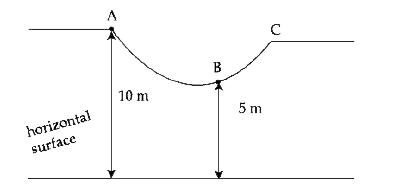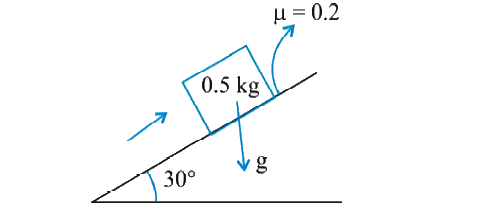A substance of mass M kg requires on input power P J/s to remain in the molten state its melting point. When the power source is turned off the sample completely solidifies is
2PtM
Pt2M
PtM
PMt
The correct Answer is:C
Topper's Solved these Questions
- PHYSICS PART2BOOK - FIITJEECHAPTER - PHYSICS PART2EXERCISE - Section (I) : Subjective
4 Videos
- PHYSICS PART2BOOK - FIITJEECHAPTER - PHYSICS PART2EXERCISE - Section (II) : MCQ
27 Videos
- PHYSICS PART-IIIBOOK - FIITJEECHAPTER - PHYSICS PART-IIIEXERCISE - NUMERICAL BASED QUESTIONS DECIMAL TYPE
11 Videos
- ROTATIONAL MECHANICSBOOK - FIITJEECHAPTER - ROTATIONAL MECHANICSEXERCISE - COMPREHENSION - IV
2 Videos
Similar Questions
A substance of mass M kg requires a power input of P wants to remain in the molten state at its melting point. When the power source is turned off, the sample completely solidifies in time t seconds. The latent heat of fusion of the substance is …….
View SolutionA substance of mass M kg requires a power input of P wants to remain in the molten state at its melting point. When the power source is turned off, the sample completely solidifies in time t seconds. The latent heat of fusion of the substance is …….
View Solution
Knowledge Check
A given substance of mass 'm' is in solid state at certain temperature. Arrange the following steps in proper sequence to calculate the total heat energy required to just convert the substance completely into gaseous state.
(A) Note down the specific latent heat of vapor ization of the substance and calculate the heat supplied to convert from liquid to gaseous state using the formula.
(B) Note down the melting point of the substance and calculate the heat supplied to increase the temperature of the solid to its melting point.
(C ) Note down the boiling point of the substance and calculate the heat supplied to increase the temperature of the substance from melting point to its boiling point.
(D) Add all the heat energies, it gives the resultant heat supplied to the solid to just convert it into gaseous state.
(E) Note down the specific latent heat of fusion of the substance and calculate the heat supplied to convert the substance from solid state to liquid state.AB D E C ABA C E D BCA B C D EDB E C A DA ginven substance of mass 'm' is in solid state at certain temperature. Arrange the following steps in proper sequence to calcualte the total heat energy required to just convert the substance completely into gaseous state.
(a). Note down the specific latent heat of vaporization of the substance and calculate the heat supplied to convert from liquid to gaseous state using the formula.
(b) Note down the melting point of the substance and calculate the heat supplied to increase the temperature of the solid to its melting point.
(c) Note down the boiling point of the substance and calculate the heat supplied to increase the temperature of the substance from melting point to its boiling point.
(d). Add all the heat energies, it gives the resultant hea supplied to the solid to just convert it into gaseous state.
(e) Note down the specific latent heat of fusion of the substance and calculate the heat supplied to convert the substance from solid state to liquid state.Ab d e c aBa c e d bCa b c d eDb e c a dThe m.p. of most of the solid substances increase with an increase of pressure . However ice melts at a temperature lower than its usual melting point when pressure is increased. This is because
Aice is less denser than H2OBpressure generates heatCthe chemical bonds break under pressuerDice is not a true solid.
A substance of mass M kg requires a power input of P wants to remain in the molten state at its melting point. When the power source is turned off, the sample completely solidifies in time t seconds. The latent heat of fussion of the substance is …….
View SolutionA calorimeter of water equivalent 10×10−3kg is filled with 70×10−3kg of a substance at its melting point. The substance is found to solidify completely in 21 minutes. A similar calorimeter containing 80×10−3kg of water at the same temperature cools at the rate of 1.5∘C per minute, the room temperature being the same in both cases. What is the latent heat of fusioin of the substance? (Specific heat capacity of water =4200Jkg−1K−1)
View Solution
As shown in the figure, a particle of mass 10 kg is placed at a point A. When the particle is slightly displaced to its right, it starts moving and reaches the point B. The speed of the particle at B is x m/s. (Take g=10m/s2 ) The value of 'x to the nearest integer is
View SolutionA block of mass 0.5 kg is kept on a rough inclined plane making an angle of 30∘ with horizontal. What power will be required to move the block up the plane (along the plane) with a velocity of 5m/s ? (Take m = 0.2 between block and plane)

View SolutionAn object of mass 2 kg is moved from infinity to a point P. Initially that object was at rest but on reaching P its speed is 2 m/s. The work done in moving that object is −16J. Then potential at P is
View Solution
